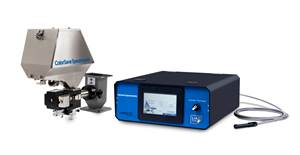Thermoset Molder Closes the Loop On Mold Temperature Control
Vernay Laboratories Inc. of Yellow Springs, Ohio, is a major producer of precision rubber fluid-control components at four plants in the U.S. and Europe. “In rubber molding, the temperature of the mold is the heart of the process, so maintaining a uniform thermal profile across the tool is vital,” says Ankur Maheshwari, program manager at the Griffin, Ga., plant, Vernay’s biggest in North America.The company was having a big problem controlling temperature uniformity in production of a special gasket seal used in printer cartridges.
Vernay Laboratories Inc. of Yellow Springs, Ohio, is a major producer of precision rubber fluid-control components at four plants in the U.S. and Europe. “In rubber molding, the temperature of the mold is the heart of the process, so maintaining a uniform thermal profile across the tool is vital,” says Ankur Maheshwari, program manager at the Griffin, Ga., plant, Vernay’s biggest in North America.
The company was having a big problem controlling temperature uniformity in production of a special gasket seal used in printer cartridges. This rectangular gasket contains 12 tiny O-rings compression molded of EDPM rubber. Vernay molds 650,000 gaskets per month using two 112-cavity molds running on 375-ton presses. Vernay uses a 300-g shot to mold the parts, which act as a fluid interconnect seal in the print head of a six-color printer. Ink flows through the inner diameter of the O-rings, so any distortion of that I.D. affects ink flow.
A prototype six-cavity tool was developed for researching the application. Scrap rates were at least 50%, due to flash in the I.D. of the O-ring. The development team found that mold surface temperature needed to be in a very tight range (±2° C) to mold a good part. But Vernay discovered that the mold surface temperature was not uniform, which also led to uneven curing. Vernay saw temperature variances of up to 5° to 10° C from one side of the tool to the other, and as much as 4.7° from cavity to cavity. “If the temperature was too high it caused flash or distortion, and if it was too low it created part surface issues,” recalls Maheshwari.
Rubber compression molds typically do not contain heating or cooling systems. Rather, the mold is heated through conduction from the platen, which is outfitted with cartridge heaters. Compression molders typically want to hold mold temperature variance to no more than 5° to 10° C. However, Vernay’s job had a tighter temperature window of just 2° to 3° C. “We needed a tight processing window, as we realized that anything outside of this temperature range caused bad parts,” says Maheswari.
Rubber compression molders typically use a single point of thermal control in the platen, adjusting all of the heaters simultaneously. Maheshwari found that the platen tended to heat up more in the center than along the edges. One option would have been to segment the platen into heat zones, but the standard open-loop control would give no indication of how close the actual temperature in the mold was to the desired temperature.
To solve the problem, Vernay teamed up with Priamus System Technologies LLC., Brunswick, Ohio, to develop what’s said to be the world’s first closed-loop, multi-zone mold-surface temperature-control system. A platen was built with cartridge heaters arranged in nine control zones. Vernay installed Priamus temperature sensors in the mold close to the cavity surface. The thermocouples are grouped in nine monitoring zones that correspond to the platen heating zones. New software, called Priamus Heat, uses the temperature registered by the mold thermocouple to drive the setpoint temperatures of the corresponding platen zone. “Every zone in the platen talks to a corresponding zone in the mold,” says Maheshwari.
Maheshwari says the closed-loop Priamus Heat system has reduced temperature variances to less than 2-3° C across the mold, eliminating hot and cold spots. Scrap rates in production are now just a fraction of what they were in the prototype. Vernay was able to increase productivity 50% just by maintaining uniform tool temperature.
Related Content
AI Machine Monitoring Arrives from Google Cloud
A new “end-to-end packaged solution” connects shop-floor machine monitoring to the cloud, with AI analytics to turn data into actionable knowledge.
Read MoreHow Production Monitoring Can Make You a Better Processor
Real-time information on all your production equipment not only boosts productivity and profitability, but it encourages proactive vs. reactive thinking and sharing of best practices. See how this approach benefited a blow molder with 19 plants.
Read MoreIndustry 4.0 Without Fear: Modular MES Software Lets You ‘Start Simple’ and Add on Later
‘Don’t be afraid of MES.’ App-based platform can start with monitoring just downtime and cycle time on a few machines and add machines and functionality later.
Read MoreColor-Measurement for Extrusion, Molding
System helps processors control the cost of quality due to color variations, using real-time color data for QC analytics and color optimization.
Read MoreRead Next
People 4.0 – How to Get Buy-In from Your Staff for Industry 4.0 Systems
Implementing a production monitoring system as the foundation of a ‘smart factory’ is about integrating people with new technology as much as it is about integrating machines and computers. Here are tips from a company that has gone through the process.
Read MoreHow Polymer Melts in Single-Screw Extruders
Understanding how polymer melts in a single-screw extruder could help you optimize your screw design to eliminate defect-causing solid polymer fragments.
Read MoreTroubleshooting Screw and Barrel Wear in Extrusion
Extruder screws and barrels will wear over time. If you are seeing a reduction in specific rate and higher discharge temperatures, wear is the likely culprit.
Read More

























